| Gratings 0.1.0b |
|
|
|
| Various gratings are investigated in Fraunhofer diffraction regime.
The slit number increases from one to nine. Left the intensity picture, center and right 1D diagrams of the intensity.
The number of intermediate lobes between the main lobes increases with the slit number and is always equal to the slit number diminished by two. As the finite grating is the product of the infinite grating with a single broad slit, the Fraunhofer diffraction pattern is the convolution of the delta comb (multiplied by the form factor) with the sinc pattern of this single broad slit. With growing slit number the approximation of the delta comb, multiplied by the form factor, can be seen.
The first two pictures are overviews of the diffraction pattern of one or two slits. From then on the lateral x scale changes to fit only the central lobe of the form factor pattern.
Between the first and second picture and in the following sequence the intensity scale of the middle diagram never changes. The scale of the right diagram in contrast is always fitting the whole profile.
The width of the broad mask slit is uncertain to one slit distance. From the fourier space point of view, it is remarkable, that for all possible choices of the slit mask the convolution integral of this different sinc functions with the delta comb is always the same. | Es werden verschiedene Gitter im Fraunhofer-Beugungs-Regime untersucht.
Die Spaltanzahl steigt von eins zu neun. Links das Intensitätsbild, in der Mitte und rechts 1D-Diagramme der Intensität.
Die Anzahl der intermediären Lappen vergrößert sich mit der Spaltzahl und ist immer gleich der um Zwei verminderten Spaltanzahl. In der Darstellung des endlichen Gitters als das Produkt aus unendlichem Gitter und einem breiten Spalt ist das Fraunhofer-Beugungsbild die Faltung aus Delta-Kamm (multipliziert mit dem Formfaktor) und der sinc-Function dieses einfachen breiten Spaltes. Mit steigender Spaltanzahl kann die Annäherung an den Delta-Kamm, multipliziert mit dem Formfaktor, deutlich erkannt werden.
Die ersten beiden Bilder sind Überblicke über das Beugungsbild von einem oder zwei Spalten. Von da an ändert sich die Skalierung der lateralen x-Achse, um bloß auf den zentralen Lappen des Formfaktorbildes zu passen.
Zwischen dem ersten und zweiten Bild und in der darauffolgenden Sequenz ändert sich die Intensitäts-Skalierung des mittleren Diagramms nie. Die Skalierung des rechten Diagramms passt dagegen immer auf das gesamte Profil.
Die Breite der Spaltmaske ist unbestimmt bis auf eine Spaltdistanz. Aus dem Standpunkt im Fourierraum heraus ist es bemerkenswert, daß für jede mögliche Wahl der Spaltmaske das Faltungsintegral dieser verschiedenen sinc-Funktionen mit dem Delta-Kamm immer dasselbe Resultat liefert.
|
| Overview | Übersicht |
| Configuration 01 | Konfiguration 01 |
| 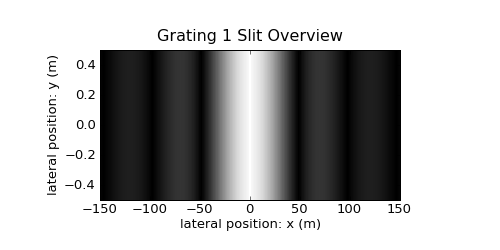
| 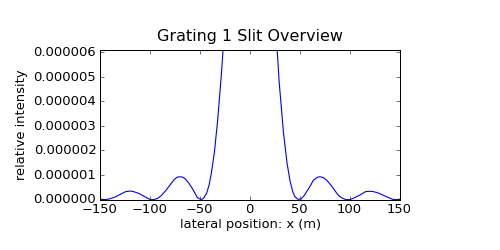
| 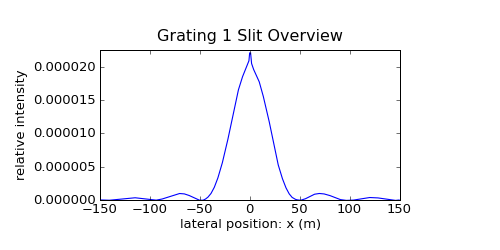
|
| Download | Download | Download |
| Overview of the Fraunhofer diffraction pattern of the single slit, taken at quasi-infinity at large
z. On the right hand side, a limitation of the used algorithm's applicability becomes visible in the innermost peak region.
The intensity diffraction pattern is the square of the sinc function.
| Übersicht über das Fraunhofer-Beugungsbild des einfachen Spalts, aufgenommen in Quasi-Unendlichkeit bei großem
z. Auf der rechten Seite ist eine Begrenzung der Anwendbarkeit des benutzen Algorithmus' im innersten Spitzenwert sichtbar.
Das Intensitäts-Beugungsbild ist das Quadrat der sinc-Funktion.
|
| Configuration 02 | Konfiguration 02 |
| 
| 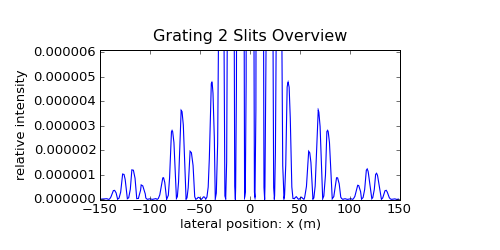
| 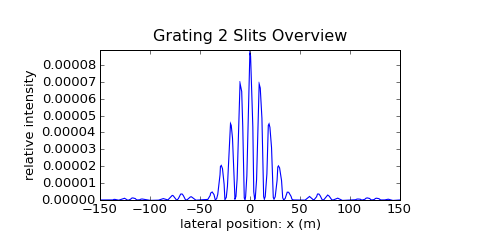
|
| Download | Download | Download |
| When two slits are combined, their amplitudes interfer. The aperture consisting of two parallel slits can be constructed by convolving the single slit aperture with a two delta peak distribution. Thus, the Fraunhofer diffraction pattern is the product of the two diffraction pattern arising from each convolution component. The factor resulting from the single slit is now called the
form factor, which is multiplied onto the higher-frequncy diffraction amplitude resulting from the double delta peak.
The Fourier transform diffraction amplitude of the double delta peak is an infinite cosine. Thus, the intensity form factor of the squared sinc function is multiplied by the squared cosine to result in the final diffraction intensity pattern visible in the diagrams.
For more slits, the form factor will in the following pictures stay always the same, as the width of the single slits incorporated is unaltered. Therefore we will focus on the central lobe of the form factor, where the real action takes place between the narrow lobes of the fine pattern. For more than one slit, the aperure is again a convolution with a multi-delta distribution, and the pattern created by them will be visible as the modulation pattern.
| Wenn zwei Spalte kombiniert werden, interferieren ihre Amplituden. Die aus zwei parallelen Spalten bestehende Apertur kann durch Faltung der Einzelspaltapertur mit der Zwei-Delta-Distribution konstruiert werden. Daher ist das Fraunhofer-Beugungsbild das Produkt aus den zwei Beugungsbildern, welche von den einzelnen Faltungskomponenten herrühren. Derjenige Faktor, welche zum Einzelspalt gehört, der sogenannte
Formfaktor, wird nun multipliziert mit der höherfrequenten Beugungsaplitude des Zwei-Delta-Peaks.
Die Fouriertransformations-Beugungsamplitude des Zwei-Delta-Peaks is ein unbegrenzter Kosinus. Deshalb wird der Intensitäts-Formfaktor der quadrierten sinc-Funktion mit der quadrierten Kosinusfunktion multipliziert, um schließlich das Beugungsbild zu ergeben, welches in den Diagrammen dargestellt ist.
Für mehr Spalte wird der Formfaktor in den folgenden Bildern immer derselbe bleiben, da die Breite der beteiligten Einzelspalte ungeändert bleibt. Daher werden wir uns auf den zentralen Lappen des Formfaktors konzentrieren, wo die wirklich spannenden Dinge zwischen den schmalen Lappen des Feinmusters stattfinden. Für mehr als einen Spalt ist die Apertur wieder die Faltung mit einer Multi-Delta-Distribution, und das von ihnen erzeugte Beugungsmuster wird dann als das Modulationsmuster sichtbar werden.
|
| Configuration 03 | Konfiguration 03 |
| 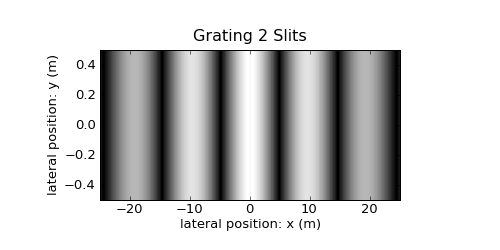
| 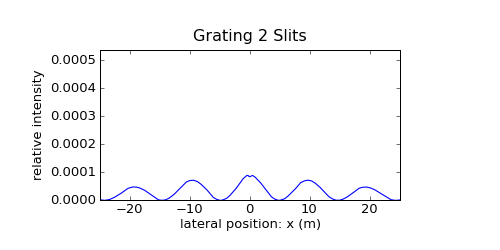
| 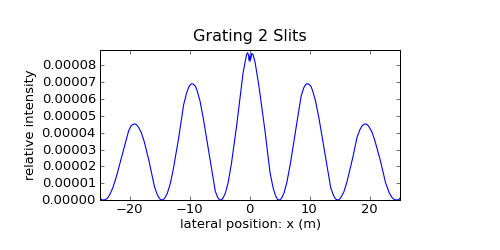
|
| Download | Download | Download |
| This is the central lobe of the form factor envelope from the single slit with the cosine square modulation from the double slit. The
x scale has been magnified as discernable from the numbers. The intensity scale in the
middle diagram has been switched. Nothing else is changed with respect to configuration 02.
| Dies ist der zentrale Lappen der Formfaktor-Einhüllenden von Einzelspalt mit der Kosinus-Quadrat-Modulation vom Doppelspalt. Die
x-Skala wurde vergrößert, wie an den Zahlen erkannt werden kann. Die Intensitäts-Skala im
mittleren Bild wurde umgeschaltet. Ansonsten wurde gegenüber Konfiguration 02 nichts geändert.
|
| Configuration 04 | Konfiguration 04 |
| 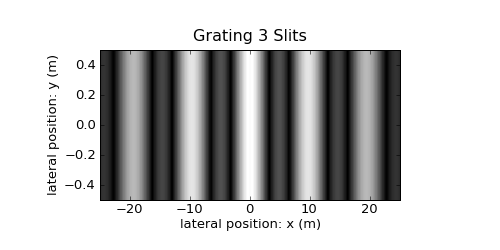
| 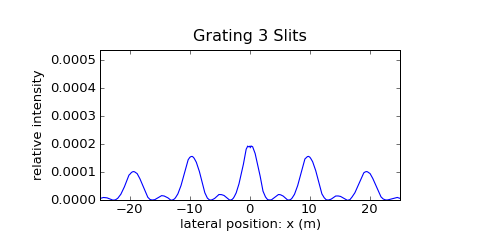
| 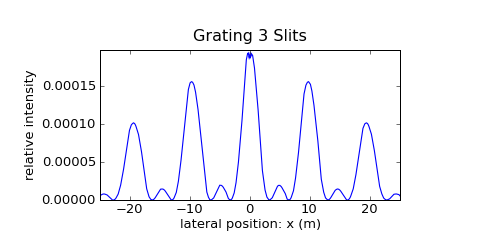
|
| Download | Download | Download |
| As is visible in the three diagrams, the pattern exhibits now the following features:
- Two roots between each two main lobes, forming the boundaries for an additional minor lobe between the main lobes.
- The minor lobes appears at the positions of the roots for two slits alone.
- The intensity of the minor lobes is much attenuated with respect to the main lobes.
- The main lobes are amplified and more pronounced with respect to the configuration with only two slits (see middle diagrams).
| Wie in den drei Diagrammen sichbar, weist das Muster nun die folgenden Merkmale auf:
- Zwei Nullstellen zwischen je zwei Hauptlappen, welche die Grenzen bilden für einen zusätzlichen Nebenlappen zwischen den Hauptlappen.
- Die Nebenlappen tauchen an den Nullstellen für zwei Spalte allein auf.
- Die Intensität der Nebenlappen ist stark abgeschwächt im Vergleich mit den Hauptlappen.
- Die Hauptlappen sind verstärkt und betonter im Vergleich mit der Konfiguration mit nur zwei Spalten (siehe mittlere Diagramme).
|
| Configuration 05 | Konfiguration 05 |
| 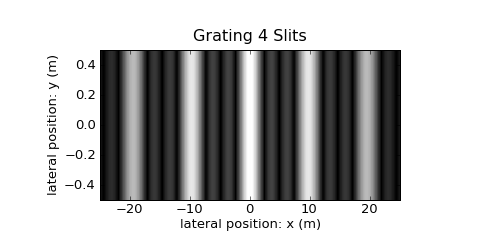
| 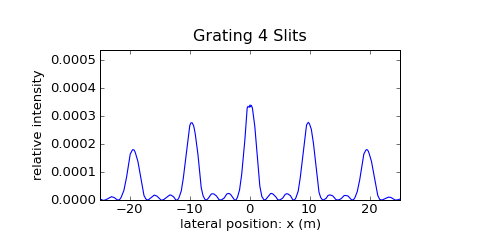
| 
|
| Download | Download | Download |
| Now there are two minor lobes.
| Jetzt sind zwei Nebenlappen zu sehen.
|
| Configuration 06 | Konfiguration 06 |
| 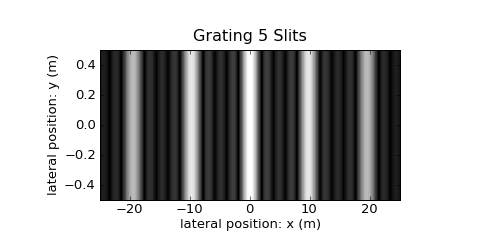
| 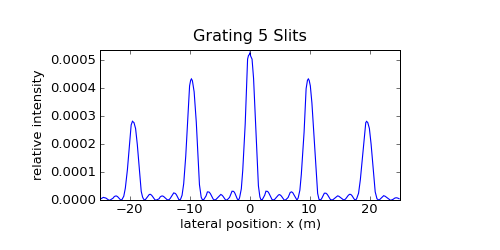
| 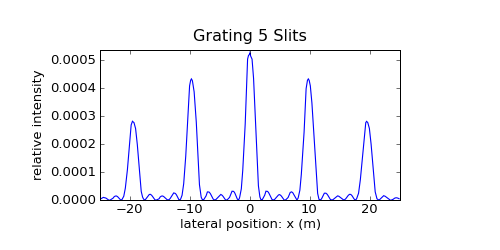
|
| Download | Download | Download |
| Configuration 07 | Konfiguration 07 |
| 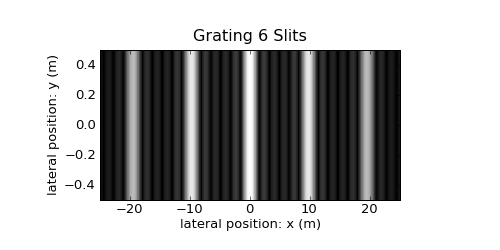
| 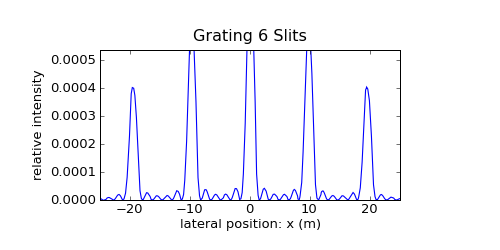
| 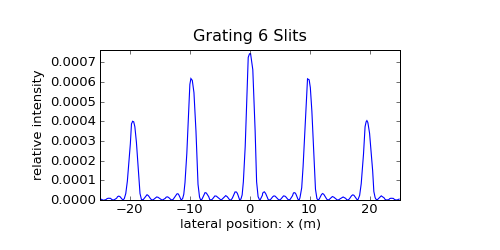
|
| Download | Download | Download |
| Configuration 08 | Konfiguration 08 |
| 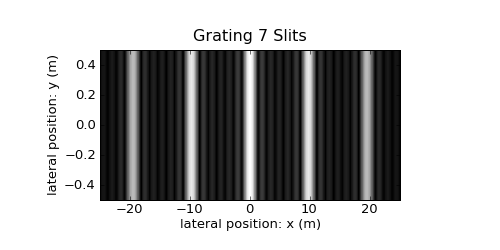
| 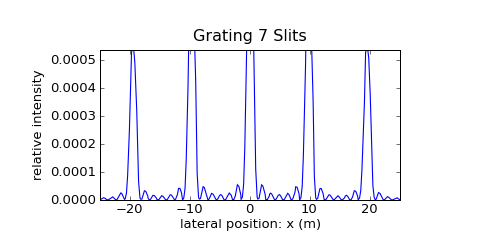
| 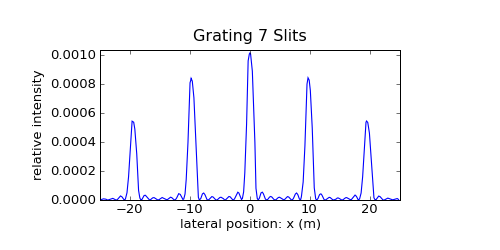
|
| Download | Download | Download |
| Configuration 09 | Konfiguration 09 |
| 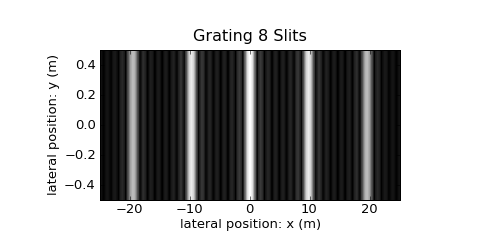
| 
| 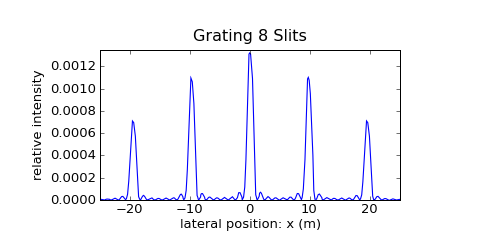
|
| Download | Download | Download |
| Configuration 10 | Konfiguration 10 |
| 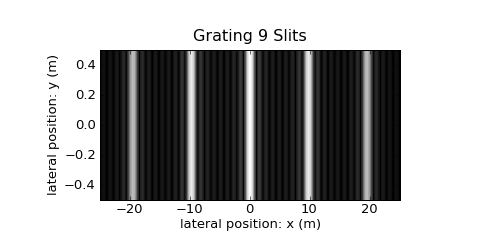
| 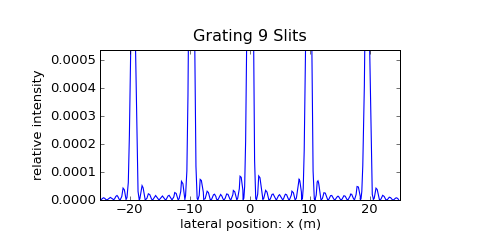
| 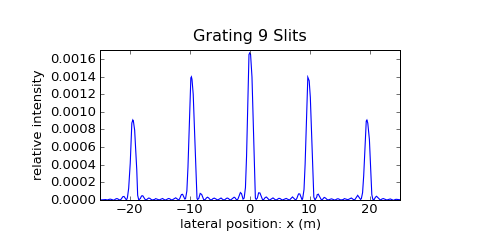
|
| Download | Download | Download |
| From comparing the different configurations using the
middle (absolute) diagrams, the following features can be discerned:
- The overall intensity as increased, as there are more slits tansmitting light.
- The peak intensity of the main peaks increases supralinearly with slit number.
- The peak intensity of the outer minor lobes increases with slit number, but sublinearly. The intensity of the inner minor lobes drops.
From the
right (relative) diagrams, the following can be seen:
- The relative intensity of the minor lobes drops with increasing slit number.
- The sharpness (the inverse width) of the main peaks increases with slit number.
For infinite many slits, the diffraction pattern will resemble a
delta comb, delta distributions in perfect array, except for form factor, without any side lobes. As infinity cannot be reached, minor lobes will always gain some intensity.
| Durch Vergleich der verschiedenen Konfigurationen unter Benutzung der
mittleren (absoluten) Diagramme kann das Folgende erkannt werden:
- Die Gesamtintensität steigt, entsprechend der vergrößerten Anzahl der lichttransmittierenden Spalte.
- Die Spitzenintensität des Hauptpeaks vergrößert sich supralinear mit der Spaltanzahl.
- Die Spitzenintensität der äußeren Nebenlappen vergrößert sich mit der Spaltanzahl, aber sublinear. Die Intensität der inneren Nebenlappen verkleinert sich.
Unter Zuhilfenahme der
rechten (relativen) Diagramme kann das Folgende gesehen werden:
- Die relative Intensität der Nebenlappen nimmt mit steigender Spaltanzahl ab.
- Die Schärfe (die inverse Breite) der Hauptlappen vergrößert sich mit der Spaltzahl.
Für unendliche viele Spalte wird das Beugungsbild einem
Delta-Kamm ähnlich werden, einer perfekten Anordnung von Deltadistributionen, bis auf den Formfaktor, ohne jeden Nebenlappen. Da die Unendlichkeit nicht erreicht werden kann, werden die Nebenlappen immer eine gewisse Intensität erlangen.
Maintained since: 6/09
$Last changed: 7/09$





























